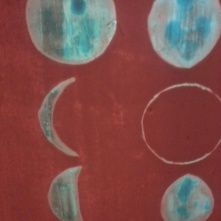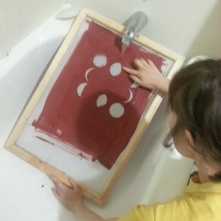I decided to experiment with technique before committing to designing and making a new print that relied on layering, in case it failed. I tried to divide my screen this time to utilize the space, and consequently time it takes to print. The screen is much larger than any of the prints I’ve made, so I thought for a multi-layered print, I would lay out each of the components on one screen. I’ve seen this division of the screen surface before in images and video of people printing, but they use painter’s tape, which I didn’t have. I tried using Scotch brand washi tape, which didn’t quite do the job of painter’s tape (which I’ve subsequently bought). I made a pond design (really an oval) on one part of the screen and simple tree shapes on the other part using drawing fluid. This was the first time I used my new brush set, and while it gave me better variance to choose from, ultimately, the medium of the drawing fluid is difficult to control (it is sort of like painting with Elmer’s white glue – it oozes and doesn’t allow for very fine detail). I printed the pond base on paper using red ink and printed my first layer of trees using black ink. I let this dry and put on another layer of the pond print, but this time I mixed transparent base in with the ink so that the first layer of black trees would show through. After the second pond layer (with transparency) dried, I added another layer of trees in between the first layer.
The transparency kind of worked, that is, the first layer of trees can be seen through the red pond layer, but the experiment print looked rough in the sense that I didn’t have control over what I was doing while making the print. I feel conflicted about this, especially realizing at the Salt Market that I am comparing my prints to prints made with another technique that is not dictated by the precision (or lack thereof) of one’s design capabilities done by hand. I have no doubt that people who are skilled graphic artists can create fine detailed prints with drawing fluid by hand, but it feels a little like comparing a handmade (and thus rough for lacking machine controlled “perfection”) thing with something that has been largely made by machine, though still handmade. Screen prints using the photo emulsion technique still need to be designed on the computer or whatever before they are set onto a screen to be printer, but they use tools and techniques (photo programs or photo images) that I cannot make on my own. My lacking design skills are keeping me from making the prints I want; my designing must improve. I found myself thinking of Ruskin and the imagination of the craftsman – maybe I need to be in an environment where I can be inspired by nature. Instead of trying to develop design skills of hand that work with computer programs, I need to find material that I can represent (and appreciate it as having charm in its roughness).
While this print brought new perspective to my process, it also killed my screen. This is my fault entirely as a neglect for my tools; I let the screen sit an entire busy day without cleaning it. I worked on it, but to no avail. The ghost of my last print lingers on he screen. I thought about continuing to print with it, but this screen is now “art” for the apartment. As a means of laying out a design, it obscures too much. And as is evident in the field of the pond, taking it to the car wash destroyed the network of the screen leaving gaps that disrupted the even distribution of ink. I bought a different screen at The Art Store that I look forward to using in making my midterm project. I’m still looking into what makes it feel different – it is not a Speedball brand, the screen is of different mesh size, is yellow, and seems to have a more rigid taut nylon feel (more like plastic) than the soft screen I was using. While purchasing the new screen, I asked advice of an artist there that printed on how to clean screens, since I continue to have trouble. She seemed baffled by this, as seems to be the attitude of seeking answers to this issue, responding that she’s never had trouble cleaning screens. I’m left in the dark. I don’t know what the mystery is behind cleaning a screen, but I’m at a loss for any other elements I can change in my work and material environment. This makes me feel a different type of failure than that of my design capabilities – who would have thought that cleaning up would be the most difficult part of making? It leaves me wondering what I don’t understand about my materials, primarily time it takes for them to set, how long they can sit, and how long it should take to care for them in cleaning. What I wouldn’t give to be able to observe a master printer in their own workshop and washtub.
































